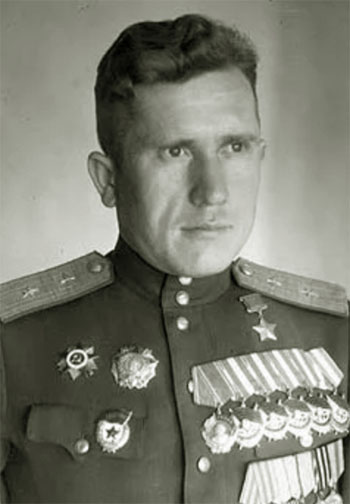
Aviation of World War II


 |
Aviation of World War II |


|
|
Soviet Union | Lend - Lease | Facts | Forum | Germany | Japan | R A F | U S A A F | Other | Photos |
|
Facts | People | Engines | Aces | Aircraft Handbook | WWII Periodicals | Contact | |
Sergei Gorelov and La-5June 23, 1920 — December 22, 2009

Sergei Dmitrievich Gorelov, Guard Major
<…> — Let's go back to the chronology of the war. How did the battles at Stalingrad go? - We arrived at Stalingrad at the end of August, after another reorganization, as a result of which we received the La-5. Here life has already gone differently ... Firstly, his speed is almost 700, if with a "pressurizer". Secondly, an amazingly tenacious machine! In one of the air battles near Stalingrad, my plane received a burst into the engine. The cockpit began to splatter with oil, but the plane still flies! I managed to reach the airfield and land. The engine stopped during the run and I was pulled into the parking lot. The conclusion of the technicians was as follows: it cannot be repaired. It turns out that two of the engine's cylinders were blown off! You imagine?! There only rods went! The same "yak" - as soon as the splinter gets into the engine, hooks on some tube and that's it. It was possible to earn extra money on the free hunt for the La-5, but we continued to accompany the attack aircraft. That's why I shot down a little. - Did the control of the engine, the propeller pitch distract from piloting in the Lavochkin's cockpit? - Kill, I don't remember. You do everything automatically. You keep the maximum speed and lower it only when you approach the airfield. In battle, the propeller is lightened, but not completely. There were other subtleties, but all this was worked out to the point of automatism, and I did not ask myself what to do in this or that situation. The build quality of the Lavochkin was good, there were never any complaints, however, we had new ones all the time. After all, we lost and lost. Backward visibility, if you turn your head, is normal. They did not rub my neck, only I had to free the laryngophones a little. There were oxygen masks, but they were almost never used. They are needed from 5000, and we rarely dropped in there. Until the end of the war, I flew in a "Lavochkin". After the war he mastered the first jet MiG-9. And before flying on a jet, we trained on "cobras" - the cabin is comfortable, you sit like in a car. We used to say about her: “America gave Russia a plane. The shaft passes through the ass and the crutch is vice versa. " The same "Lavochkin" has a worse cabin. And in the "yak" it is very cramped, and the plane itself is narrower. But like an airplane "Cobra" is heavy, although at altitude it is nothing. "Lavochkin" is more maneuverable and faster. In total, I have flown 50 different types of aircraft. I did not fight on the "yak", but flew on it a lot. Yak-3 is very light, maneuverable like a feather. It is slightly inferior in speed to Lavochkin-7, but stronger in maneuverability. - Which German plane was the most difficult to shoot down? - Fighters, of course. They maneuver. Catching them in the crosshairs is very difficult. You need to have skills and ability. Rama is also difficult to shoot down, and bombers and transport planes are easy prey. They can be overwhelmed from the first attack. "Focke-Wulf" is less maneuverable than "Messerschmitt", but it has more firepower and speed. They are equally difficult to shoot down. Although, you know, sometimes you do not understand who you are knocking down: "Messer" or "Focke-Wulf". Rarely, but it happened, they knocked down their own. In our regiment, from the beginning to the end of the war, this never happened. We did not feel pity for the Germans. An enemy is an enemy, especially a fascist. We thought they were all beasts. They recalled how cruelly their pilots acted in 1941-1942. And therefore, there could be no question of any pity or condescension. There was hatred. And after the war, after 10 - 15 years, hatred for the enemy remained. Even communicating with German pilots already now, 3-4 years ago, when so much time has passed, there is still something between us, we could not make friends. True, we were friends with the GDR pilots in the Soviet years, but also somehow ... there was some kind of attitude ... In short, a German is a German. Most of all German planes were shot down in 1943, and then in 1944 and 1945 I practically did not shoot down - by the middle of the war, air supremacy was already ours. Near Lvov, a large number of German aircraft were rare. So, 3 - 5 aircraft is the maximum. As soon as they felt that you were starting to build a maneuver, you went on the attack, they left. They only suddenly attacked, tried not to get involved in the battle. |